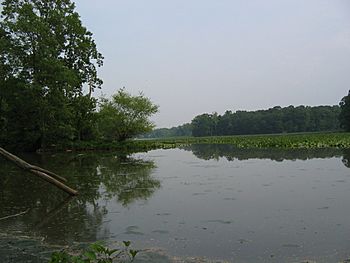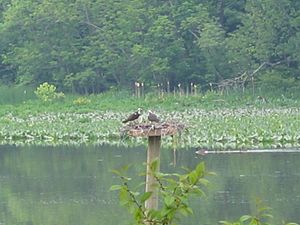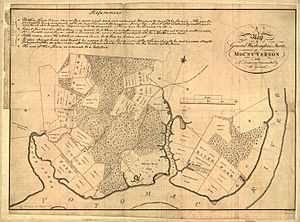Little Hunting Creek facts for kids
Quick facts for kids Little Hunting Creek |
|
|---|---|

Little Hunting Creek, viewed from its east bank looking south
|
|
| Country | United States |
| State | Virginia |
| County | Fairfax County |
| Physical characteristics | |
| River mouth | Potomac River 0 feet (0 m) |
| Length | 3.6 miles (5.8 km) |
Little Hunting Creek is a small waterway in Fairfax County, Virginia. It is about 3.6 miles (5.8 km) long. This creek flows into the Potomac River. It is a "tidal" creek, meaning its water levels change with the ocean tides.
A stone bridge built in 1931 crosses the creek's narrow opening. This bridge is part of the George Washington Memorial Parkway. The famous George Washington and his family built their Mount Vernon home right along this creek. Today, many homes are also built along its banks. Little Hunting Creek is a great spot for fishing and seeing local wildlife.
Contents
History of Little Hunting Creek
Long ago, in the early 1600s, Native Americans from the Doeg tribe lived near Little Hunting Creek. This was when explorer John Smith was exploring Virginia.
Later, the land around the creek became owned by John Washington. He was the great-grandfather of George Washington. What was first called "Little Hunting Creek Plantation" grew into George Washington's famous Mount Vernon estate. The creek actually divided the Mount Vernon property into two main parts: the Mansion House Farm and the River Farm.
In 1765, when new church areas were created, Little Hunting Creek helped mark the boundary for Fairfax Parish.
Building the Creek Bridge
In 1929, engineers planned a bridge over Little Hunting Creek. This bridge was for the Mount Vernon Memorial Highway. It was finished in 1931. Other small creeks along the highway were filled with dirt to save money. But Little Hunting Creek could not be filled. The ground under the creek was too soft and unstable. So, a bridge was needed instead.
By the 1960s, more and more neighborhoods began to appear on both sides of the creek.
Understanding the Creek's Watershed
The water in Little Hunting Creek starts far away. It begins in Huntley Meadows Park, about 3 miles (4.8 km) from where the creek meets the Potomac River.
Three main streams feed into Little Hunting Creek:
- The South Branch is in the Stratford Landing neighborhood. It flows into the main creek near the Potomac River. This branch splits into two smaller parts.
- The North Branch breaks off from the main creek about 1.5 statute miles (2.4 km) upstream from the Potomac. It flows northeast.
- The Paul Spring Branch is even further up the North Branch, about another 1.5 statute miles (2.4 km). It runs north through the Hollin Hills community.
Wildlife in Little Hunting Creek

Little Hunting Creek is a busy home for many animals. You can often see migratory birds like mallards and Canada geese. Large birds such as great blue herons and great egrets also visit.
Birds and Mammals
Ospreys build their nests on posts in the creek. Even Bald eagles have been seen flying overhead. If you look closely, you might spot muskrats or even a beaver in the water. On land, groundhogs and foxes live in the nearby woods.
Fish Species
The creek is also full of fish. Common types include catfish, carp, perch, and largemouth bass. In 2004, a new type of fish, the invasive northern snakehead, was found here. This was one of the first times it was seen near the Potomac River.
Recreation and Fun Activities
Little Hunting Creek is a great place for outdoor fun. You can paddle a canoe or kayak far up the creek. How far you can go depends on the tide. Many homes along the creek have private docks. From these docks, people can launch small boats into the creek and then into the Potomac River.
If you visit the Stratford Landing neighborhood, you can often watch nesting ospreys. A road called Thomas J. Stockton Parkway runs right alongside the creek, offering good views. The creek is especially popular for largemouth bass fishing.
In 2004, there was a discussion about whether people should be allowed to build duck blinds and hunt ducks on the creek.
Swimming is not recommended in the creek.


